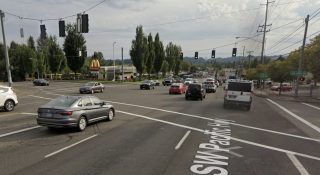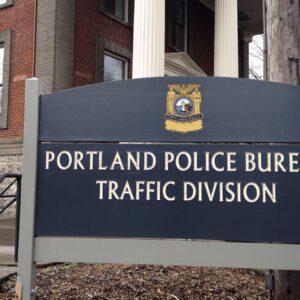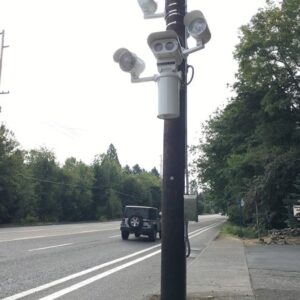
It only took 17 days for Tigard’s two new traffic enforcement cameras to rack up over 800 citations. And just a few minutes for that city’s mayor to draw a line between this rampant, normalized lawlessness and death.
The new cameras started issuing citations on July 14th at 72nd Avenue and at Hall Boulevard on Highway 99W in Tigard. By July 31st, the 72nd Ave location had snapped 662 potential violators.
At a Tigard City Council meeting on August 11th, Police Chief Kathy McAlpine recounted some of the dangerous behavior behind the numbers. McAlpine said the cameras caught one person doing 74 mph in a 35 mph zone and in more than one occasion drivers have been cited multiple times at the same intersection — including one person who was caught going one way and then caught again on their way back. Another driver was dinged four separate times in the 17 days.
Advertisement

On average, Chief McAlpine estimated people are driving about 14-15 mph over the posted speed limit. To put that in perspective, research shows a person walking is likely to be killed 25% of the time if hit by a driver going 32 mph. If the driver is going 50 mph the risk of death goes up to 75%.
“It’s some pretty blatant driving patterns that we’re seeing.”
— Kathy McAlpine, Tigard police chief
“You have people pretty much disregarding the posted speed limit there,” the chief said. “It’s some pretty blatant driving patterns that we’re seeing.”
This section of 99W has a tragic history with a long record of collisions, injury and death. According to City of Tigard there were 114 collisions at these two intersections from 2012 to 2016.
For Tigard Mayor Jason Snider, a lightbulb seemed to go off as he listened to Chief McAlpine’s presentation. “I want to acknowledge the very profound volume of citations at 72nd,” he commented. “That seems really dramatic. What’s interesting to me about it is we’ve had three pedestrian deaths within a block of that intersection within the past 5 years and I guess we’re starting to see why.”
Bingo. As safety advocates have been screaming to anyone who will listen for many years: Speed kills.
Unfortunately, current state law limits the impact of these cameras. Not only does the law (ORS 810.434) allow drivers to go 10 miles per hour over the speed limit before being cited, but a related statute (ORS 810.436) requires a police officer to sign off on each citation issued in order for it to be valid.
Tigard’s police chief said the stacks of violation records have been a “big heavy lift” for her officers and have accounted for about “half a months worth of work.”
Learn more about the City of Tigard’s traffic camera program on their website.
— Jonathan Maus: (503) 706-8804, @jonathan_maus on Twitter and jonathan@bikeportland.org
— Get our headlines delivered to your inbox.
— Support this independent community media outlet with a one-time contribution or monthly subscription.





Thanks for reading.
BikePortland has served this community with independent community journalism since 2005. We rely on subscriptions from readers like you to survive. Your financial support is vital in keeping this valuable resource alive and well.
Please subscribe today to strengthen and expand our work.
On one hand, I’m tempted to say we should install cameras at all the signalized intersections. They clearly are an efficient way to catch speeders and red-light-runners. But on the other hand, in this day and age I find it hard to support anything that could even have the potential to be used for more surveillance…
I would love to know what happens to the data of people who are not speeding. Collected? Stored? Deleted? Shared with other agencies? Sent to ICE?
The cameras only photograph when the violation threshold is crossed.
I am happy to hear this; I would feel more comfortable if no-collection-of-the-innocent were enshrined in law (and perhaps it is).
It often is. For example, during the protests, cops can’t legally film non-criminal activity of protestors. But it would be great to have it around basically everything and also for you to request docs around yourself (maybe you can?).
Another great example of where you have privacy protections even when you are in public and everyone can see what you’re doing.
Too bad the cops are violating it nightly and not being held accountable.
I’m personally more than willing to give up privacy in the name of public safety. If you use nearly any sort of social media or internet services you’re already under fairly heavy “surveillance.” If we installed these at the majority of traffic signals and implemented automatic fines and license suspension for x number of tickets, I think we’d see a drastic change in driving behavior. That is, if we actually enforced our laws against driving with a suspended license, no insurance, among other things. As Kittens said, officers won’t do anything about reckless driving even if it happens just feet away. Just today I watched someone do a burnout and run through a red in front of a cop with zero response.
The thing is, there’s no reason for you to need to trade privacy for safety. There is no inherent conflict between automated traffic enforcement and good data privacy. None.
Rather than talk about it in terms of a trade-off, let’s talk about implementing the system properly, so we get the benefits without the costs.
Fair enough. My take is that implementing the system properly in this case would be ensuring that all data collected from anyone who is found not to be in violation of the law is deleted immediately. Of course, this would have to be coupled with installations at all trouble spots equally to avoid any systemic bias.
No data is collected if the trigger threshold is not crossed.
That is great to hear.
Then you should consider not using an activity tracker. Its routine now for LE to obtain so called geofence warrants to pull dragnet mass activity tracker data and cross correlate with crime scene coordinates and times. Unlike the hypothetical misuse of red light camera data, the use of geofence warrants for mass data pulls of cyclists and joggers (but not drivers of course) activity tracker data has already resulted in false arrests and false convictions. Its an ongoing and growing trend in LE.
https://nakedsecurity.sophos.com/2020/03/10/google-data-puts-innocent-man-at-the-scene-of-a-crime/
The problem is — and always has been — scale. A warrant based on individualized suspicion is a vastly different creature than a circumstantial correlation of many. The difference is the lynch pin of our system of justice. When law enforcement must hypothesize first and then find the evidence to prove, the opportunity for mistakes and malfeasance goes down as there are many possibilities for an innocent victim to disprove the narrative. When law enforcement gets to first see all the possible evidence and then craft a story to suit, there is no longer room for an innocent party to rebut or present a contradictory story. The reality is that many stories implicating many different people may fit the available data, and letting law enforcement cherry-pick from among them heavily weighs the balance against the defense.
Those familiar with statistics will understand. If there is a suspect X and some evidence correlating X to an incident A, the probability of finding A given X is not the same as the probability of finding X given A, especially when the relative probabilities of X and A are hugely different, as is almost always the case in this kind of scenario.
Put another way, the chance of finding a needle in a haystack is small when you have only one haystack. If you have every haystack that ever there was in the world, you’re all but certain to find one or probably more needles. If you had some reason to look at the first haystack, finding a needle there is indicative. If you look at every haystack ever and find a needle, that’s not very indicative of anything.
The conclusion is that querying large sets of information without individualized suspicion in the course of an investigation is harmful to due process. One way to fight that is to avoid and restrict amassing large sets of information, particularly in possession of the government. That’s why automated license plate scanner data, traffic enforcement data, facial recognition data, and location data should be deleted as soon as it reasonably can be. Pulling in presence data of everybody in a location at a particular time as part of an investigation makes me shudder.
Until you start getting into things like this – https://www.vice.com/en_us/article/k7q55x/police-across-canada-are-using-predictive-policing-algorithms-report-finds
yikes
That’s part of why I don’t use Strava or other activity trackers 🙂
Likely the minute you leave your house you start showing up on cameras. Almost every private business, bus, porch, etc. has a camera now. A few more at public traffic intersections will not make a difference. There is no right to privacy in public locations. Driving is not intended to be a private activity which is why you need to have a licence plate, registered car, and a drivers licence. If you break the law on a public road you should expect to be held to account.
I never said anything otherwise. Don’t put words in my mouth that I didn’t say.
You are generally right… and yet that rule has exceptions. For example, the police can’t place a GPS tracker on your car (without a warrant) to see where you go in public (even though it is the information equivalent to them following you), and you have an “expectation of privacy” in a public phone booth.
A lot of of the rules around privacy that made sense when surveillance was difficult may change in the face of easy tracking. There’s a lot of interesting questions that remain unsettled.
https://www.theatlantic.com/technology/archive/2015/03/supreme-court-if-youre-being-gps-tracked-youre-being-searched/389114/
You can certainly make the choice for yourself that you have no privacy and you don’t care. I am not willing to do the same for myself, and I don’t want someone else to determine that for me, either.
The general principle that public locations aren’t private holds. But the extreme extension of that principle is that one is freely surveilled in all they do from the moment they leave their house until they close the door upon their return. I’m definitely not comfortable with that, yet the scale of private corporate data collection draws us closer to it. When that vast data is freely shared with the government without limitation or oversight (as in the case of Ring), it becomes a concern for the reasons I outlined above.
I don’t care if one picture is taken of me on a public street. But if enough pictures are taken of enough streets that one can constructively determine my whereabouts and actions at essentially any time, the boundary between “streets are public” and “you need a warrant to track or surveil me” has been lost, and that is what I mean when I say I’m concerned about the scale of data collection. The latter situation was inconceivable at the time most of our common law and legal structures were created.
The world is gradually coming to grips with concerns like this, although the responses to it, like GDPR and CCPA are nibbling around the edges rather than tackling the issue head-on.
One thing I have been thinking is that red light cameras don’t shoot unarmed black people, they don’t initiate stops based on race and they don’t try and search your car. You speed, you get a ticket (and I say this as a person who has paid many tickets over the years). I think a lot of the problem is that people who might get a pass from the Cops (ie white people) are suddenly held accountable for their driving actions based simply on their behavior. Speed? pay the fine. Speed a lot? Lose your license. If you are concerned about data collection throw away your phone.
Also as a side note my wife has family up in Tigard and that section of 99 is really bad in a car, and pretty much unwalkable/bikeable. It would need a major road diet but the cu;-de-sacs are everywhere up there. Also this is near the area where I found tack strips in the bike lanes. So bike friendly it isn’t.
As long as they only take pictures when someone runs a red light (which is how many seem to work) I don’t see an issue.
I wish my mayor in Greensboro NC could connect the dots, she still thinks that any car moving at the posted speed limit is polluting more than a car going as fast as possible, and that pedestrians are getting killed because they are either drunk or distracted with their cell phones. (Severe life-changing injuries don’t count, of course.)
The underlying culprit of this terrible stretch of 99 is that ODOT has 5-7 vehicle lanes designed like a rural highway through a relatively dense suburban commercial corridor on a very busy bus line through low-income areas (Metzger/ Tigard Triangle). There are only about 4 signalized intersections for pedestrians to cross in the mile between 217 and I-5, most of which only have one crosswalk per intersection (the other being “closed”). I cross regularly by bike at 78th/Dartmouth to the bus stop, and the intersection designs are unbelievably hostile to vulnerable road users, with slip lanes and turn signals prioritizing car users. Hopefully the cameras will help, but design is the only thing that will drastically make this road safer. Too bad the Southwest Corridor Light Rail project doesn’t even propose to reduce driving capacity on Barbur/99.
I don’t know. Sure it will solve the problem there but people quickly acclimate to the cameras and will just abide the law in that one particular spot. I see this all the time at the speed cam on Marine Drive and 122nd.
It would be more productive if the police were more visible enforcing traffic laws. Right now, it feels like “The Purge”… anything goes. Officers don’t even care if it happens right in front of them.
These are a good start. A few mobile photo enforcement trucks would be great to keep people from getting used to obeying laws only at intersections.
Can they still catch them if they use illegal tinted license plate covers? I rarely see these used in Calif or Wash. but they are all over Oregon. They seem like a hit and run tool to me, as well as radar and toll collection evader device.
They do not work.
https://mythresults.com/episode73
For camera’s they don’t. For humans trying to read them, they sure do.
The covers are illegal. I always wondered how often cops pull over people and cite them for it. I imagine they don’t help “consideration” for people who are already pulled over.
Cameras have a role to play, but they have drawbacks. For one thing, their mere presence is a distraction that draws peoples’ attention away from the road. They also encourage people to do things like check their speedometer too often and use cruise control in busy areas.
Additionally, I, as a pedestrian / cyclist / driver, have a hard time reading any license plate of a vehicle with these smoked covers when its moving in traffic…it is very difficult to then report to PD illegal / unsafe driving behavior. Thus these covers need to go…please OR legislature do something.
This is a step in the right direction, and I hope that many more cities follow Tigard’s lead.
Go big or go home! Lower all speed limits in downtown centers to 20 mph MAX!!!
For what it’s worth, Main Street in Tigard (which is kind of like their downtown) is 20mph.
However, 99 is pretty nuts.
Deputize volunteers to review those tickets. I’m sure it’s not rocket science, and there’d be a line to help.
Even hiring a new officer to do it would pay for itself based on the number of citations they are generating now.